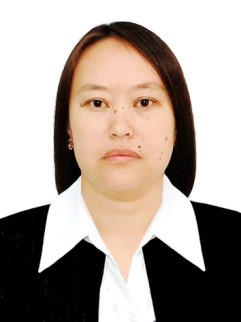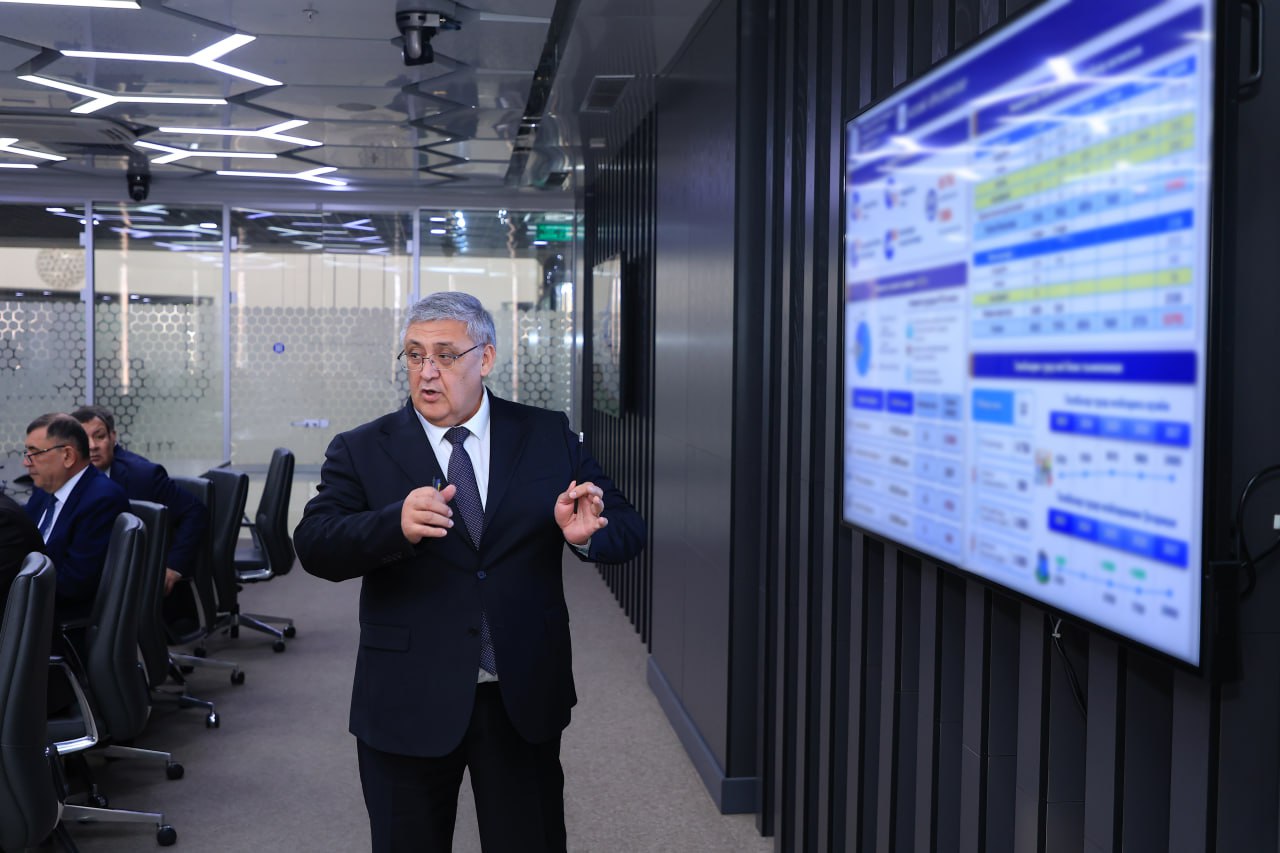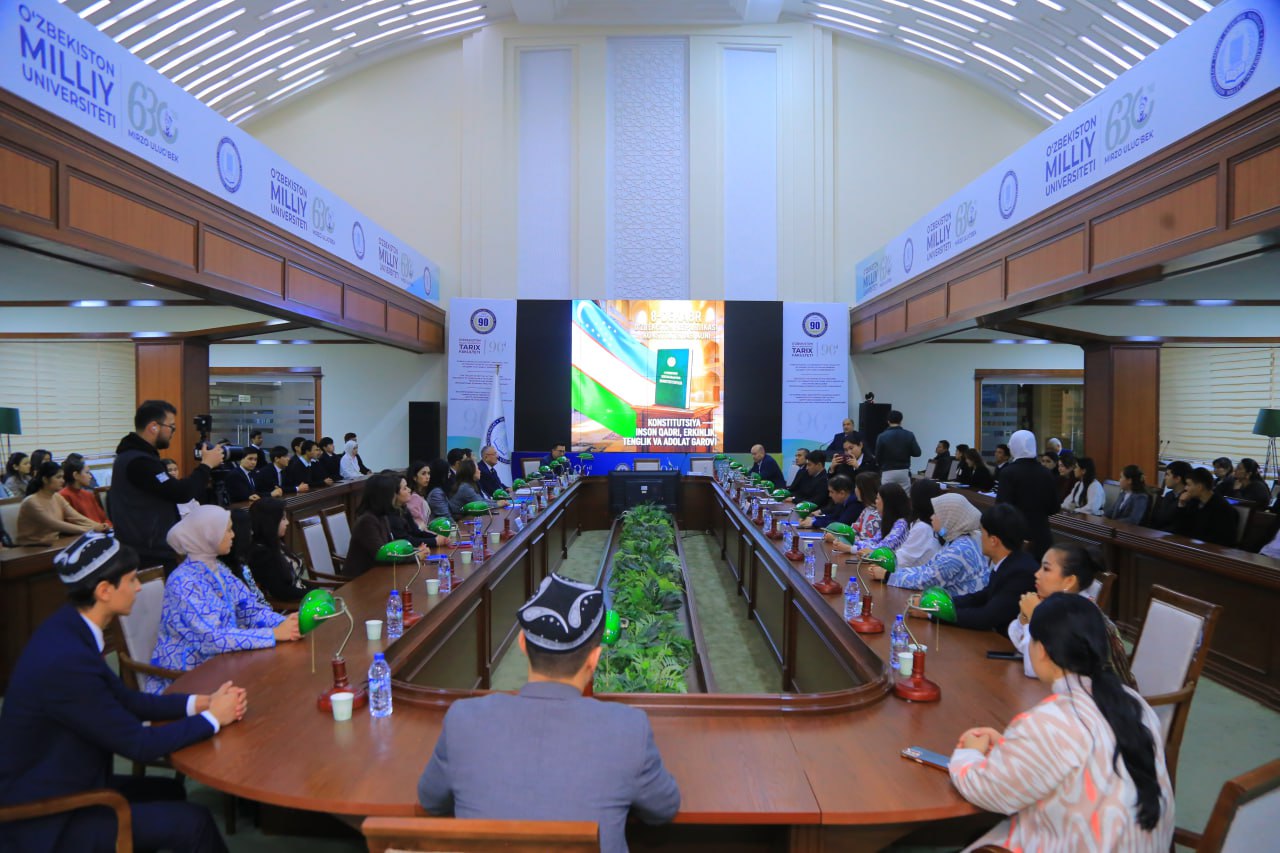
Xoshjanova Kamila – Head of department
100174, Universitet street 4, Olmazor district, Tashkent
Monday-Friday, 14:00 – 17:00
+998 97 746-18-75
e-mail: kamila-kh@mail.ru
HISTORY AND MAIN ACTIVITIES OF THE DEPARTMENT OF GEOGRAPHY AND MINERALOGY
The history of the Department of Geochemistry and Mineralogy dates back to 1924. Professor A.S. At the initiative of Uklonsky was formed in 1927 as a separate department of mineralogy and until 1974 was the head of the department. The department of “Petrography” was founded in 1952 and until 1983 was headed by EM Isamukhamedov.
The founders of the Department of Mineralogy were academician AS Uklonsky, a graduate of Moscow State University in 1920, and the Department of Petrography and Lithology in 1942. V.I.Popov, I.Kh.Khamrabaev, T.N.Dalimov were awarded academic titles in the field of mineralogy, geochemistry, petrography, more than 10 doctoral dissertations were defended (R.I. .Koneev, A.A.Koldaev, A.A.Kustarnikova, LNLordkipanidze H.D.Ishbaev, R.T.Dalimov, R.A.Khalmatov, etc.), about 100 – candidate’s dissertations were defended . Most of the graduates are working as leading specialists in production. Graduates of the department worked at the university as rectors (academician TN Dalimov), vice-rector, dean (H.D. Ishbaev, EE Igamberdiev, AZ Umarov).
For the last 30 years The department was headed by T.N.Dalimov, H.D.Ishbaev, R.I.Koneev, O.Kushmurodov, A.Z.Umarov, K.K.Khoshjanvova.
In accordance with modern requirements, the departments are now merged and renamed the Department of Geochemistry and Mineralogy.
Bachelor’s degree:
- 5141200 – Geochemistry
Master’s specialties:
- 70530507 – Geochemistry, geochemical methods of prospecting
- 70530509 – Mineralogy and crystallography
- 70721601 – Geology, prospecting and exploration of mineral deposits (by types of deposits)
Doctoral (PhD Dsc) specialties:
- 04.00.02 – Geology, prospecting and exploration of solid minerals. Metallogeny and geochemistry
- 04.00.03 – Geotectonics and geodynamics, Petrology and lithology.
SUBJECTS TEACHED AT THE DEPARTMENT
| № | Fan name | Brief information about science |
| Bachelor’s degree | ||
| 1 | Mineralogy and crystallography | In the practical application of minerals in various sectors of the economy and industry, and in the discovery of their new types, the study of their physical properties, their relation to the chemical composition and crystal structure. |
| 2 | Petrography | It consists of the study of the structure and texture of rocks, morphological forms, conditions of formation and petrographic properties. |
| 3 | Geology of minerals | Types of mineral deposits and conditions of their formation, as well as the characteristics of the formation and location of deposits in the Earth’s crust, the geological structure of metallic and non-metallic mineral deposits of different genetic groups and the paragenesis of minerals in them. |
| 4 | Geochemistry | The chemical elements that make up minerals, the distribution of chemical elements in the earth’s crust, in different rocks, the causes of the accumulation of chemical elements cover all the issues of their origin. |
| 5 | Uranium mineralogy and geochemistry | Diagnosis of the conditions of formation of uranium minerals, their physicochemical properties, the separation of paragenetic mineral associations according to the conditions of formation of minerals. |
| 6 | Petrochemical research methods | Preparation of rock samples for various chemical analyzes, analysis of the results of chemical analysis and petrochemical methods used in their processing, comprehensive analysis and correct interpretation of the results of processing data on the chemical composition and geochemical properties of rocks. |
| 7 | Mineralogical research methods | Processing of minerals at different stages in mineral deposits consists of the study of ore and ore deposits by mineralogical and geochemical methods and the interpretation of the results obtained. |
| 8 | Geochemistry of rare and scattered elements | The study of the causes of the accumulation, accumulation and displacement of rare and dispersed elements in magmatic, pegmatite, hydrothermal and metamorphic processes. |
| 9 | Petrographic research methods | It consists of studying the optical properties of igneous rocks, the structure and texture of minerals, mineral associations. |
| 10 | Mineragraphy | The study of ores in rocks by microscopic methods involves the study of the optical properties of mineral minerals. |
| 11 | Mineralogy of jewelry stones | It consists of knowing the basic methods of correctly identifying gemstones and jewelry stones, as well as learning how to process, decorate, polish and polish them. |
| 12 | Technological mineralogy in the assessment of minerals | It consists of understanding the technological processes in the extraction and processing of minerals, the behavior of minerals in technological processes. Technological properties of minerals used in the enrichment process and chemical and structural properties of minerals affecting the enrichment processconsists of learning. |
| Magistracy | ||
| 1 | Crystallography and crystal chemistry | Knowledge of the conditions of formation of crystals, general concepts about crystals, geometric crystallography, interpretation of crystallographic projections in the laboratory, the use of various microscopes, binoculars and additional detection equipment in the study of crystals. |
| 2 | Geochemistry of mineral deposits of Uzbekistan | The study of the mineral resource base of Uzbekistan and its prospects, geochemical types of deposits, geochemical methods of prospecting, types of mineralogical and geochemical associations and the causes of mining in geological processes. |
| 3 | Evolutionary geology | It consists of identifying various processes in the gradual development (evolution) of the Earth and analyzing and interpreting the data obtained using the methods used in the reconstruction (reconstruction) of past geodynamic conditions. |
| Fundamentals of nanogeochemistry | Nanogeochemistry is a branch of geochemistry that studies the distribution, concentration of elements, and the amount of ppm-ppb (106-109 tons) in the form of elements found. They study elements such as gold, tellurium, selenium, bismuth, antimony, mercury and others in nano, dwarf scales. involves familiarity with probe analysis. | |
| 4 | Mineralogy of radioactive and rare earth elements | Determination of mineral forms of radioactive and rare earth elements, their diagnosis by physicochemical properties, separation of paragenetic mineral associations according to the conditions of formation of minerals. |
| 5 | Methods of search analysis | Grinding of samples obtained by slip methods in mills, their delivery to laboratories, identification of minerals with high specific gravity, to teach students to successfully use the method of slip analysis in the search for rare and rare earth minerals and other metal ores. |
| 6 | Gemmology | To study the physical and chemical properties of precious and jewelry stones, the use of field and laboratory methods in the study of jewelry stones, the use of colored stones as decorative stones in the national economy, mineralogy of ornamental stones, optical properties of ornamental stones, methods of carving ornamental stones, methods of working with equipment used in stone processingconsists of. |
| 7 | Mineragenia | Modern concepts of the emergence and development of the main structural-formation zones of the Earth’s crust, the specific types of geological and mining formations inherent in these structures, the study of methods for creating predictive-metallogenic maps of different scales. |
| 8 | Petrogeochemistry | The formation of relevant knowledge, skills and abilities in students through a comprehensive analysis and correct interpretation of the results of processing data on the chemical composition and geochemical properties of rocks. |
| 9 | Metallogeny and mineral deposits specific predictions | It consists of offering targeted projects in areas belonging to different hierarchical units and training specialists who are able to confidently organize geological prospecting in accordance with modern requirements. |
| 10 | The theory of development of the mineral resource base | The system of development and development of mineral resources formed in Uzbekistan during the years of independence, its applicable laws, principles, requirements and procedures for receiving geological information. |
| 11 | In the stages of geological prospecting geological and economic assessment | The basics of geological and economic assessment, the laws, principles, requirements and procedures for processing geological information, which ensure the effective operation of the system of development and development of mineral resources formed in Uzbekistan during the years of independence, are taught to students. The set of internal and external requirements in this area is aimed at providing broader knowledge to future professionals. |
| 12 | Magmatism and ore formation processes | Endogenous (magmatogenic, hydrothermal, telethermal, etc.), exogenous (erosion, debris, residue, etc.) and metamorphogenic processes that ensure the formation of ore are reflected in space and time, reflected in the conditions of their location, morphology, mineral composition and structure is to study At the same time, attention is paid to the analysis of genetic issues of minerals and deposits – the ways of their formation. |
RESEARCHERS AND SCIENTIFIC WORKS
| № | The research professor-teacher F.I.Sh. | Type of research | Subject and supervisor of the dissertation |
| 1 | Akbarova Zuhra Tashtemirovna | PhD doctoral student | “Mineralogical and geochemical criteria for the formation of uranium deposits of the sandy type of Western Uzbekistan (based on the comparison of the deposits of Djasaga, Djengeldy and Zapadny Ziaetdin).” Supervisor g.-m.f.d. A.A.Xalilov |
| 2 | Saxibov Turmon Koylievich | PhD doctoral student | Mineralogical-geochemical properties and prospecting of gold mining (Oriental prospective area in the Auminza Mountains). Supervisor – Ph.D., Associate Professor KK Khoshjanova |
| 3 | Oripov Saidazimkhoja Giyos oglu | PhD doctoral student | Laws of localization of gold mineralization in the eastern Kyzylkum province. Scientific adviser -g.-m.f.d., A.E. Antonov |
| 4 | Khaliyorov Kholmurod Khalmirzaevich | PhD doctoral student | Location law of copper ore between Shaugaz and Kondirsay (in the East Almalyk mining area) Supervisor – Ph.D., Associate Professor KK Khoshjanova |
Scientific projects. Grants, practical and innovative and economic contracts for research work have been implemented at the department:
- F-5.1.2 Nanocrystalline structures are self-organizing
mineral-geochemical system – a new approach to the problems of education and development of natural and technogenic areas of useful iskopaemyx. 2004-2007 yy. Supervisor Koneev R.I.
- A-4-104 Method search, tipizatsii i otsenki skrytogo zolotogo
orudeneniya on the basis of micromineralogicheskogo and geochemical analysis selenidno-telluridnyx sistem. 2004-2007. Supervisor Koneev R.I.
- A13-16 Terms of localization, mineral-geochemical composition
i perspektivy netraditsionnogo zoloto-platino-palladievogo orudeneniya v Almalyk-Angrenskom gorno-rudnom rayone. 2015-2017 yy. Supervisor Koneev R.I.
- x / sh 11/09 Mineralogo-petrograficheskie issledovaniya na
Zengibobo-Sheyxdjeylinskoy and Urusayskoy ploshchadi gor Sultan-Uvays NPTs Geology dragotsennyx metals and uranium 2010-2011yy. Supervisor Koneev R.I.
- x / sh 1/12 Mineralogo-petrograficheskie i analiticheskie
issledovaniya po zone okisleniya i pervichnym rudam rudoproyavleniya Yasvay i uchastka Karatau NPTs Geologiya dragotsennyx metalllov i urana 2010-2012 yy.
- x / sh 5/11 Mineralogo-petrograficheskie i analiticheskie
iissledovaniya na Zapadno-Sheyxdjeylinskoy ploshchadi gor Sultan-Uvays NPTs Geology dragotsennyx metallov i urana 2010-2012 yy. Supervisor Koneev R.I.
- x / sh 5/12 Izuchenie veshchestvennogo sostava, mineralogo
geoximicheskix osobennostey okislennyx, pervichnyx rud i porod rudoproyavleniya Kyzyltash i mineralizovannyx zon uchastkov Tayman, Severnыy Tayman NPTs Geologiya dragotsennyx metallov i urana 2011-2014 yy. Supervisor Koneev R.I.
- F8-17 Natural nanotechnologies and nanoparticles in processes
obrazovaniya rudnyx mestorozhdeniy blagorodnyx i tsvetnyx metals. Geological, mineralogical-geochemical regularities and practical investigations. 2012-2016 yy. Supervisor Koneev R.I.
- OT-F8-01 Golden Uzbekistan: new concepts
rudoobrazovaniya, evolyutsii orudeneniya vo vremeni i prostranstve, problemy prognozirovaniya, poiska i otsenki novyh i netraditsionnyx mestorozhdeniy 2017-2020 yy. Supervisor Koneev R.I.
- OT-F8-02 Nurata mountain ore area produces daykai crops
laws of existence and their role in ore formation 2018-2020 yy. Scientific adviser Ishbaev H.D.
LOCAL AND FOREIGN PARTNERS
Foreign partners:
- Kazan Federal University
- Russian State Geological Research University
- University of Tromsø, Norway
Local partners:
- Institute of Geology and Geophysics named after HM Abdullaev
- Institute of Mineral Resources
- Museum of Geology
- Center for Advanced and Innovative Technologies
- Institute of Advanced Training and Retraining of Geological Network Staff DK
DEPARTMENT STRUCTURE
| № | Professor-teacher F.I.Sh. | Position | Academic degree and academic title | Scientific directions | Phone E-mail |
| 1 | Xoshjanova K.K. | Chair holder | G.-m.f.n. docent | Mineralogy and crystallography; Geochemistry of rare and scattered elements; Geochemistry of mineral deposits of Uzbekistan | (99897) 746 18 75 kamila-kh@mail.ru |
| 2 | Ganiev I.N. | docent | docent | Mineral geology; Petrochemical research methods; Petrology | (99890) 134 64 61 iganiev@mail.ru |
| 3 | Shukurov A.X. | Associate Professor v.b. | G.-m.f. PhD | Petrology; Basics of petrography | (99890) 799 30 10 buxarist.best@mail.ru |
| 4 | Atabaeva N.E. | Great teacher | General geochemistry; Petrology; Mineragraphy | nasinamova2003@mail.ru (99890) 358 72 00 | |
| 5 | Xaliyorov X.X. | teacher | General geochemistry; Petrology; Applied mineralogy | xolmurodgeolog@gmail.com (99888) 125 03 89 | |
| 6 | Ro’ziev M.A. | teacher | Petrology; oil and gas geochemistry; Petrology | mansur.abdirashidovich@gmail.com (99894) 407 09 08 | |
| 7 | teacher | Fundamentals of Geophysics and Geochemistry; Mineralogy and crystallography4 Geology of minerals | ziyaeva1974@mail.ru (99890) 910 03 80 | ||
| 8 | Shanazarov S.I. | teacher | Mineralogy and crystallography; Petrology; Mineragraphy | shanazarovS@mail.ru (99893) 439 07 76 | |
| 9 | Akbarova Z.T. | teacher | Mineralogy and crystallography; Petrology | akbarova.zt@mail.ru (99897) 4434488 | |
| 10 | Zayniddinov F.A. | teacher | Mineralogy and crystallography; Petrology | (99890) 3553343 | |
| 11 | Umarov A.Z. | docent | G.-m.f.n. docent | Crystallography and Crystal Chemistry; Mineralogy of jewelry stones | (99890) 9086297 uakrom@mail.ru |
| 12 | Tsoy V.D. | professor | G.-m.f.d. professor | Methods of analysis of geochemical data; Geochemistry of elements | (99893) 5133457 |
| 13 | Pirnazarov M.M. | professor | G.-m.f.d. professor | Specific predictions of metallogeny and mineral deposits; The theory of development of the mineral resource base | pirnazarov59@inbox.ru |
| 14 | Sadiqova L.R. | professor | G.-m.f.Dsc. | Gemmology; Mineralogy of radioactive and rare earth elements | samotsvet1@rambler.ru |
| 15 | Xalmatov R.A. | professor | G.-m.f.Dsc. | General geochemistry; mineragraphy; Fundamentals of nanotechnology and nanomineralogy | (998909923259 info@cht-tashkent.uz |
| 16 | Turapov M.K. | professor | G.-m.f.d. professor | Evolutionary geology; Petrology | |
| 17 | Khalilov A.A. | professor. | G.-m.f.d | Geochemical research methods; Applied mineralogy | (99890) 9157053 |
| 18 | Shukurov N.E. | docent | G.-m.f.n. | Ecological geochemistry; Mineralogy of radioactive and rare earth elements | (99890) 3540373 nosirsh@gmail.com |
| 19 | Roziqov O.T. | docent | G.-m.f.n. | Technological mineralogy; Method for determination of gas-liquid mixtures in minerals | odil.razikov@mail.ru |
| 20 | Jo’raev M.N. | docent | G.-m.f. PhD | Technological mineralogy in the study of ores; mineralogy and crystallography | (99890) 9731183 |
SCIENTIFIC LABORATORIES
Head of the Scientific Laboratory “Middle Tien Shan Magmatism and Geodynamics” Associate Professor IN Ganiev.
Laboratory equipment and instruments.
1. MP-3 polarization microscope (for laboratory classes in petrography).
2. Microscope MIN-8 – for research work.
3. Microscope “POLAM” – for research.
4. Model of binocular microscopes MBS-1 and MBS-2 for mineralogy and slip analysis.
5. MIN-9 microscope – for working with petrographic sections.
6. Wood crystal forms in all syngoniums (for lessons from crystallography).
7. Rocks and mineral collections (for classes in petrography, mineralogy, geology of mineral deposits).
CIRCLES
“A young geochemist”Educational circle – scientific supervisor, associate professor KK Khoshjanova and teacher HH Khaliyorov.
TALENTED STUDENTS
- Abdukhalikov Abdurahmon –Student of the Year 2021 y.


